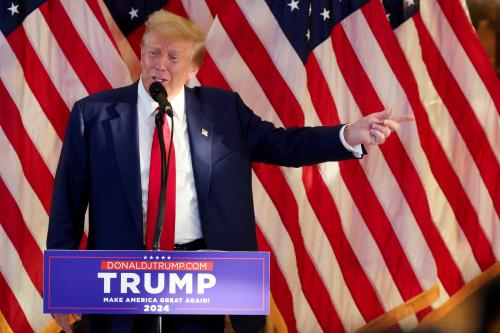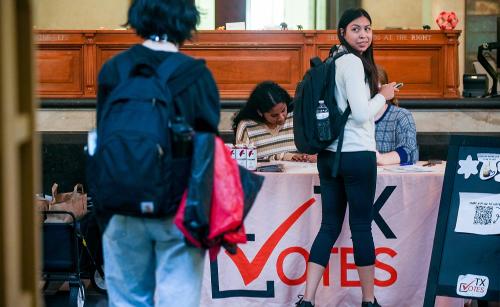In politics, the “gender gap” is the difference in the percentage of women and the percentage of men voting for a given candidate.1 The political gender gap has appeared in one way or the other in every election since 1980 with women tending to vote for the Democratic Party and men tending to vote for the Republican Party. But the apparent gender gap among young voters also appears in measures other than politics and points to some deeper and potentially even more concerning issues among young people.
In politics, we are seeing a gender gap amongst today’s youngest voters—aged 18 to 29—with young women being significantly more Democratic in their political leanings than young men. For instance, a recently released national poll by the Institute of Politics (IOP) at Harvard Kennedy School finds that among 18 to 29-year-olds, President Biden’s lead with women is +33 points in contrast to young men where his lead drops to a mere six points. When compared to this stage of the 2020 campaign, Biden’s lead among women was nearly identical (+35), while his lead with men stood at +26, representing a steep drop in just the past four years.
When it comes to party identification, Democrats have again lost significant ground with young men. In 2020, 42% of young men in Harvard’s poll identified as Democrats versus 20% who identified as Republican. Now, 32% are Democrats and 29% are Republicans, with the number of independents remaining relatively unchanged. Women over the same period have not moved as much. In 2020, 43% of young women in Harvard’s poll identified as Democrats, and 23% were Republicans. Now, 44% are Democrats, and 18% are Republicans.
Meanwhile, a recently released Economist/YouGov survey shows a staggering rise in support for Donald Trump among young people. In fact, the rise in Trump favorability among the young outstrips the rise in favorability among all other groups in the population except Democrats and liberals. We should view these polls with caution, especially because the subgroups are often too small to be statistically significant.
There are other indications of a growing gender divide among young people that goes deeper than just politics. For instance, a longitudinal analysis by international research agency Glocalities between 2014 and 2023 highlighted the growing rift in Gen Z. It found that young women have become significantly more liberal and embraced “anti-patriarchal” values over the last decade, while young men have stayed relatively the same. Additionally, it showed that young men have been the slowest among all groups to move towards more liberal values over the nearly 10-year period.
Glocalities found young women are most concerned about issues like “sexual harassment, domestic violence, child abuse and neglect, and mental health problems.” Men were generally more focused on “competition, bravery, and honor.” The study found young men have become more patriarchal in their orientations overall when compared with women and even older men.
The analysis further linked “feelings of despair and societal disillusionment, a focus on patriarchal values, and rebelling against cosmopolitan liberal values” to the growing rise of the radical right. This leads many to fear that as young men are resisting the tides of change, they may be vulnerable to far-right groups and movements who promise a return to more patriarchal systems which offer a break from the social developments which they believe have begun to unfairly work against their societal interests.
Gallup recently studied the gender divide and found roughly 25% of men aged 18 to 29 identify as “liberal,” versus 40% of women in the same demographic—up from 28% in 2003. Men were found yet again to be relatively unchanged in their self-identification during that timeline.
The Survey Center on American Life’s findings also support a divide in self-identification, with young women being much more likely to identify themselves as “feminists” than young men. Only 43% of Gen Z men identify in this way, much less than Millennial men, while 61% of Gen Z women describe themselves as feminist compared to 54% of Millennial women and 49% of Generation X women.
The study also shows young men increasingly feel as though they are experiencing discrimination over the past four years. Nearly half of all men aged 18 to 29 said they felt this way, the highest of all male age groups surveyed.
Men in particular feel isolated. Brookings nonresident senior fellow, Richard Reeves, has studied the issue arguing in his book “Of Boys and Men” that rapid societal changes combined with a market shift from brawn to brain have left many men feeling bereft and without purpose. Reeves, a self-described “feminist”, does not make the argument that the liberation of women is a bad thing but instead suggests finding new roles for men and a redefinition of “masculinity” in this changing world.
Young men have repeatedly been found in recent years to be apathetic towards voting, with young women in recent election cycles constantly turning out to vote at higher rates than young men. Politically, this is good news for Democrats. After all, there are more women than men in the country, they make up a larger portion of the electorate, they are more motivated to vote, and vote blue. From a societal perspective, it could signal potential danger if young men feel less tied to democracy and feel no need to participate in the democratic process while increasingly becoming disheartened with their social status. The incentive for change and action may be there, but not through democratic means. This is made more disconcerting by the fact that this is coming at a time when democracy could yet again be in peril this election year. But what exactly are men experiencing which could make this scenario a potential reality? Well, young men are overwhelmingly the loneliest demographic, with 63% of men aged 18 to 29 reporting being single, compared to 34% of women in the same age group.
Suicide rates among men in 2021 were four times higher among males than females. Men commit almost 96% of the mass shootings in the country, demonstrating how men are very likely to act upon their social isolation in extremely violent ways. In education, women now receive 58% of bachelor’s degrees and 61% of master’s degrees, representing yet another area where men are increasingly falling behind.
The social isolation of men creates major ramifications for women as well. Based on Census Bureau historical data and Morgan Stanley forecasts, 45% of prime working age women (ages 25 to 44) will be single by 2030—the largest share in history—up from 41% in 2018. The social bonds of previous generations appear to be eroding among young people, and this has serious consequences for coupling, future birth rates, and social cohesion.
There are also darker concerns about the potential backlash to recent social developments. History is littered with examples of nations suffering from the consequences of young men finding themselves idle without purpose.
We may be in the opening stages of a social backlash to the progressive social movements of the past decades. When significant societal change occurs, some may feel left behind or cheated. Right now, young men fall into that camp. The challenge now will be ensuring that the backlash does not transform into real damage, especially for women. If the aim is to build a fairer equitable future where all feel they have a role and are respected, the polling of Gen Z appears to show we are moving in the opposite direction.
-
Footnotes
- The gender gap in economics refers to the differences in wages between men and women.






Commentary
The growing gender gap among young people
May 23, 2024